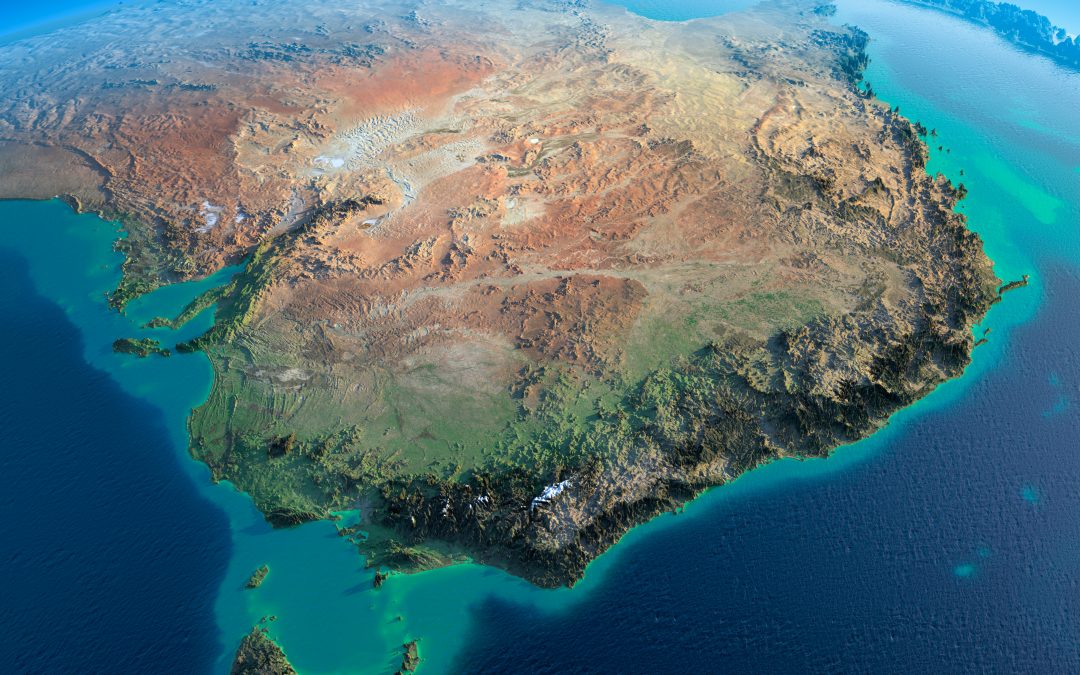
Ah, Australia. The land of spiders, surfing and sunshine. Lots of sunshine – about 3000 hours per year, in fact[1].
Australian weather is not just extreme – it’s also surprisingly erratic and diverse. It’s the climate of the champions, and we wouldn’t want it any other way. But why are we talking to you about the weather?
We’re not just making small talk: when designing and manufacturing products down under, there are key things we must consider to ensure that your product survives our harsher climate(s).
THE AUSTRALIAN CLIMATE
The Australian climate has an international reputation for being hot and dry, however what is less known is the large diversity in climate zones found throughout the continent. Down under, we seem to range from one extreme to the next, with climate sectors that are tropical, subtropical, temperate, desert, and dry Mediterranean. Some cities such as Melbourne can experience all four seasons in a single day, going from hot and dry to wet and humid in just 24 hours[2].
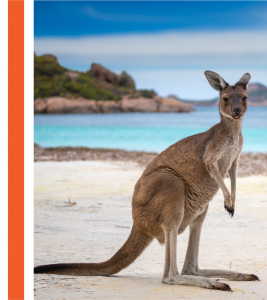 We have miles of outback terrain which can reach up to 50 degrees Celsius in summer with little to no rain for years on end, as well as coastal areas which experience up to 100 inches of rain annually with heavy wind and rainstorms[3].
We have miles of outback terrain which can reach up to 50 degrees Celsius in summer with little to no rain for years on end, as well as coastal areas which experience up to 100 inches of rain annually with heavy wind and rainstorms[3].
Then we have the barely spoken about ‘Australian Alps’, which are often covered in snow and can reach -2 degrees with a max of 22 degrees during Summer[4]. Even the outback itself is also barely recognized for its freezing winters and unpredictable weather during the cold season.
There is high humidity across the entire country, particularly in the warmer seasons, as well as cold fronts and strong winds coming in from our neighbouring continent, Antarctica[5]. Importantly, we also have the weather influence of El Nino and La Nina, our two default climate settings which are respectively characterized by either severe drought, hot desert winds and bushfires, or storms, floods and cyclones.
All of this diverse adversity means we, as designers and manufactures, have to understand how these weather patterns ultimately impact our products.
THE THREATS
Our climate is gradually getting more unpredictable. We are seeing an increasing trend in severe weather patterns[6], as well as changes in the way products are used and perceived. The expectation for quality is becoming more enforced as an awareness surrounding pollution and climate change is increasing.
This means our design and manufacturing skills have required some needed refinement to ensure longevity for your products, particularly when working with plastics. By increasing the quality and thus product lifetime of plastic commodities, we can significantly contribute to deteriorating the climate issue by making less products which are more durable, as opposed to single use plastics which are very quickly rendered unusable and consequently discarded. There are key considerations which we must account for when constructing any product, but this is particularly true for outdoor and industrial commodities.
Firstly we must determine the weather patterns in the environment which your product will be exposed to. Things such as excessive humidity, UV light exposure, rain, wind and extreme temperatures can degrade material or negatively impact them over time. Repeated drops or impact wears the material down over time, and can consequently change its properties as well as its structural integrity.
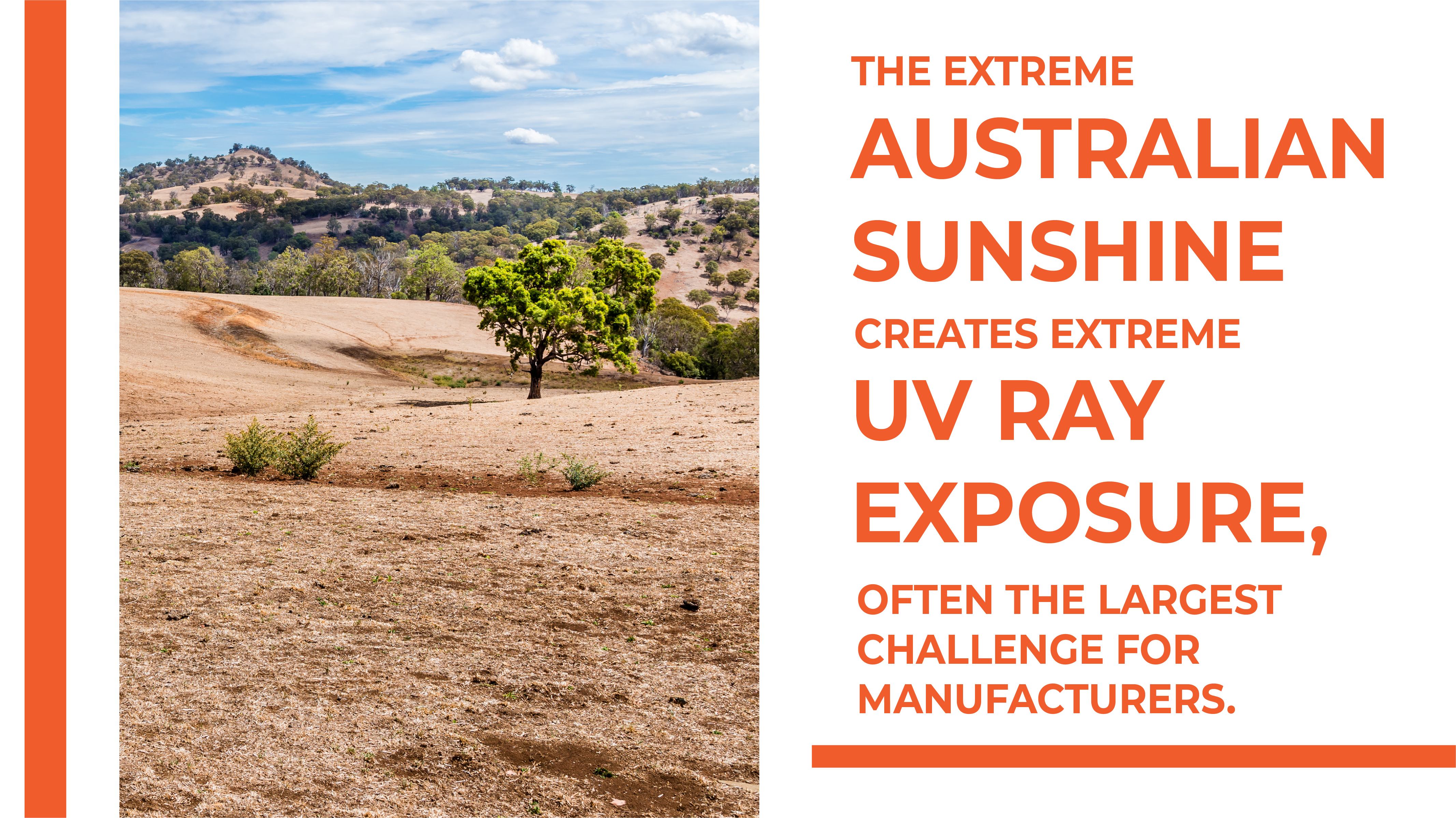
Also important is the context of product use. Whilst this is not specific to Australia alone, it is still an important consideration. Products which will undergo high velocities, be in pressurized environments, or which will endure sustained vibration, dragging or abrasions, must all accommodate for those factors. For example, should a product be destined for use in one of our coastal regions, it will likely be in contact or even submerged in our salt waters, and thus should be fit for purpose. This can even include accounting for excessive dust, dirt or sand, a common issue experienced in our outback landscapes.
Below are some quick insights regarding key factors which help us ensure our plastic products are Australia-proof. Namely, we need focus on things such as material selection, relevant additives, shape and size, and component quality.
THE SOLUTIONS
MATERIAL SELECTION
Perhaps the most obvious factor to consider is your products material. Selecting the right material means choosing the properties which best accommodate for the aforementioned threats.
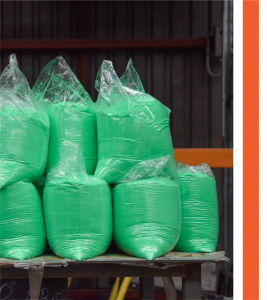
Specifically in the plastics family, there are several options for durability and outdoor resilience. Polycarbonate has excellent weatherability, as well as Polyvinylidene (PBDF) and several forms of Polyethylene, such as XLPE and LLDPE. For rain and saltwater exposure, we consider HDPE, Acetal and Nylon, which are commonly used in subsea applications. You can read a more in-depth analysis of the different type of plastics here, as well as a summary of specifically the Polyethylene family specifically (known as the most popular plastic) here.
If you’re looking to create your product out of wood, certain factors should be considered. Generally, wood will ignite are around 250°C[7]. This may initially seem safe, but during hot and dry summer months the risk of fires skyrocket and it does not take much to spark a flame and heat up timber products quickly. Some woods are naturally more resistant to fire than others, such as Azobe, Birch and Cedar, however as a rule it is safer to apply treatments or coatings with fire-retardant properties for protection, including certain paints. However, it is impossible to make wood entirely fire proof.
Metals are generally the safest option for protecting your product from the effects of heat, as it has high melting temperatures which only a few exceptions such as Pewter, which melts at 170 degrees and is often reserved for photo frames and other decorative indoor applications. However, it may fail to protect the user, as metal absorbs heat and can reach scorching temperatures when in the Australian sun. For products which need to be handled, lining relevant parts of your product with rubber or certain fabrics can prevent burns and alleviate this issue, depending on the requirements of your specific product.
In some circumstances, these protective solutions may impede on the use of your product: for example, park slides cannot be lined without compensating the slippery qualities essential to its core function. In these cases, products should avoid metals and may instead be better suited for certain plastics which can better dissipate the heat, particularly with the assistance of heat-reducing paints which are harder to apply effectively on metals.
Other good materials for heat protection include concrete, gypsum or stucco, and brick – although, ironically enough a singular brick is more fire resistant than a wall of bricks. There is also fire resistant glass, such as Pyrobel, which is a multi-laminated glass with intumescent interlayers which significantly increases the materials insulation properties. These are niche materials more usually found in construction settings, however, and are not commonly suitable in industrial settings for product design.
Regardless, whether you need protection from floods, bushfires or chemical spills, there will always be a suitable material to do the job.
If you need a material which can really handle the heat, try Tantalum Carbide or Hafnium Carbide. This material can withstand temperatures over 4000 degrees, enough to survive the heat generated from leaving and entering our Earth’s atmosphere. We don’t even have an existing technology available to sufficiently test the melting point[8]. It might be a bit complicated, expensive, and an overkill, but at least you know your product would survive if it was thrown into space. Which is pretty… cool.
ALLOYS AND ADDITIVES
Also on the topic of materials, alloys and additivities are more specifically targeted solutions to many of the issues encountered in designing for the Australian climate, or for more extreme conditions.
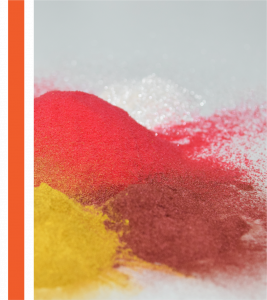 Plastic has a wide range of characteristics, and finding the right fit is often a process of altering and combining properties to check off the relevant boxes. One of the ways we do this are with alloys and additives or modifiers, helping us to counter and curb the natural limitations in plastic.
Plastic has a wide range of characteristics, and finding the right fit is often a process of altering and combining properties to check off the relevant boxes. One of the ways we do this are with alloys and additives or modifiers, helping us to counter and curb the natural limitations in plastic.
For example, ABS is perhaps the best plastic for impact strength and is highly resistant to cold temperatures – however in the heat, it is ineffective with poor weatherability. Polycarbonate-ABS alloy however, combined the temperature resistance, strength, and chemical resistance of the two plastic types.
Plastics are already pretty resilient towards chemical exposure as well as fungal infestations in high humidity environments. However additives are used to enhance these properties to make them suitable for the more extreme environments or conditions in use. Other common additives include flame retardants for fire prevention, antistatic for improved surface conductivity, antioxidants for oxygen exposure, and UV light stabilizers.
SIZE AND SHAPE
Within harsh environments, products with certain shapes and sizes are more vulnerable to failure.
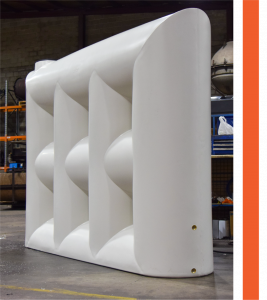 In heat, products are susceptible to warpage, and in the cold they may become brittle. For many industrial products which are in the outdoors, exposed to the elements year-long, there are tactics we use to prevent breakage which can be subtly incorporated or integrated into the product’s design.
In heat, products are susceptible to warpage, and in the cold they may become brittle. For many industrial products which are in the outdoors, exposed to the elements year-long, there are tactics we use to prevent breakage which can be subtly incorporated or integrated into the product’s design.
For a start, products should be engineered to maximise the efficiency of their shape, for example by using cylinders and rounded faces for vessels, we can maximise the strength of the product against pressure loads. We can also use a variety of different ribbing techniques to add strength to certain areas of the part. Rotational moulding ribbing is directional, meaning It is placed in a calculated direction to ensure the best strength is achieved, and normally bulky. Injection moulded ribbing, however, will normally criss-cross around the product and be 2/3rd of the wall thickness to avoid aesthetic blemishes.
Other strategies such as using thick insulating foam walls are also used where necessary to keep the contents inside the product at a stable temperature, or to reduce the likelihood of warpage during extreme temperature changes.
COMPONENT QUALITY
The integrity of each individual part is of upmost important, and this includes assembly components. These pieces should never be overlooked; they’re literally holding your product together!
 It is easy to put components such as fasteners at the back of your mind, but a product is only as strong as it’s weakest link. So the quality of fasteners, casters, caps and plugs should all be considered. This would also depend on your application and products location. If your product will be used in coastal regions or exposed to sea water, you definitely need to ensure that you opt for stainless steel for all your bolts nuts and washers. Meanwhile in a less punishing environment, galvanized might be acceptable.
It is easy to put components such as fasteners at the back of your mind, but a product is only as strong as it’s weakest link. So the quality of fasteners, casters, caps and plugs should all be considered. This would also depend on your application and products location. If your product will be used in coastal regions or exposed to sea water, you definitely need to ensure that you opt for stainless steel for all your bolts nuts and washers. Meanwhile in a less punishing environment, galvanized might be acceptable.
If your product is going to be out in the sun and needs wheels, you might want to rethink adding on that pair cheap casters. Poor quality rubbers and plastics will wear out faster than your product, and you might find your wheels significantly less round then you would like.
Keep in mind that there are a plethora of different plastic grades. You might have the highest UV protection possible on your tank, but if you slap on a plastic cap that has no protection, you might find it cracking and compromising your product much sooner than expected.
Considering the required quality levels for each piece going into your product helps ensure you are truly investing in longevity, not wasting time and money on partial protection which compromises the entire product. For this reason we encourage everyone to choose their components carefully to ensure the final product is strong, durable and capable of surviving even our Aussie climate.
AVOID
Specifically for the hot Australian temperatures, there are certain approaches we avoid to ensure longevity.
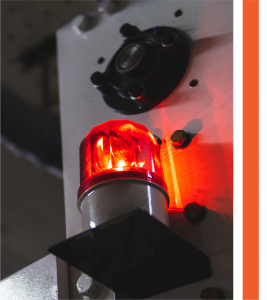 Adhesives are generally avoided, both internally and externally. Anything from flex, vibration, thermal fluctuations and humidity can all wear down adhesive substances and cause them to fail altogether. Dust and sand, both found abundantly in here down under, are also culprits for loosening adhesives.
Adhesives are generally avoided, both internally and externally. Anything from flex, vibration, thermal fluctuations and humidity can all wear down adhesive substances and cause them to fail altogether. Dust and sand, both found abundantly in here down under, are also culprits for loosening adhesives.
On a more superficial, aesthetic note, the colour of your product can greatly impact its function as well. Darker colours are typically avoided as they absorb heat, while lighter colours reflect it. This is commonly known in reference to clothing options, but should be considered for other products as well, including industrial applications.
With temperatures reaching up to 50 degrees, products exposed to the elements can reach up to double that temperature. This is detrimental for the product’s structural integrity, and even worse, can render the product totally unusable, particularly for hand-held parts.
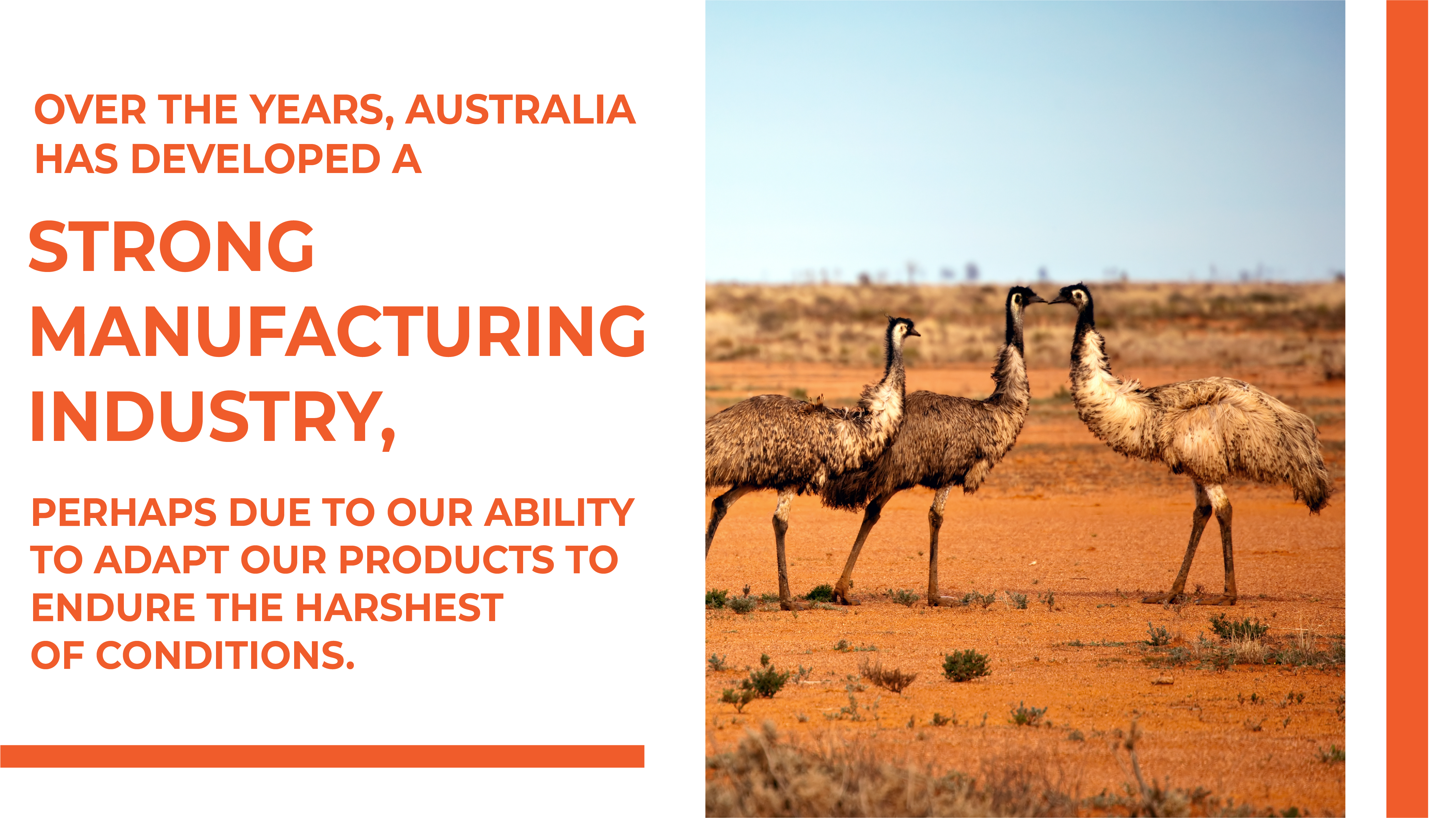
Designing down under can be a challenge, but one we are well equipped to handle. Years of experience in design and manufacturing, not to mention our experience simply living here, has prepared us. Whether you’re dealing with the Australian climate or another extreme environment, these tips will hopefully help you prepare your product, for better and for worse.
References
[1] Climate and average weather in Australia (weather-and-climate.com), Weather & Climate, ‘Climate and Average Weather in Australia’, World Weather & Climate Information
[2] https://www.gostudy.com.au/australia/climate-australia/, Go Study Australia, ‘Australia’s Climate’, Go Study Australia Pty Ltd
[3] Climate of the World: Australia | weatheronline.co.uk, Weather Online, ‘Australia’, Weather Online
[4] Australia climate: average weather, temperature, precipitation, when to go (climatestotravel.com) World Climate Guide, ‘Climate – Australia-, Climates to Travel
[5] https://www.gostudy.com.au/australia/climate-australia/, Go Study Australia, ‘Australia’s Climate’, Go Study Australia Pty Ltd
[6] https://premierbuildingsolutions.net/2020/02/product-design-for-extreme-environments/ Kelly Mullen, 2020, ‘Product Design for Extreme Environments’, Premier Buildings Solutions.
[7] Tsoumis, G. Thomas (2022, February 18). wood. Encyclopedia Britannica. https://www.britannica.com/science/wood-plant-tissue
[8] Caroline Brogan, 2016, Imperial College Lonson, ‘New record set for world’s most heat resistant material’, New record set for world’s most heat resistant material | Imperial News | Imperial College London

